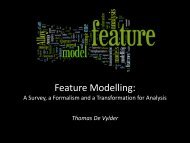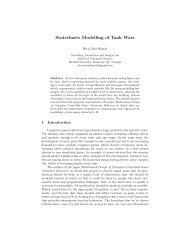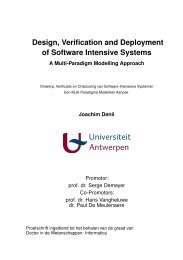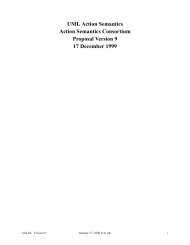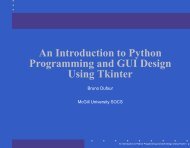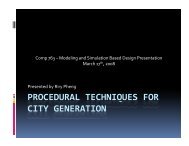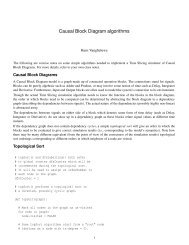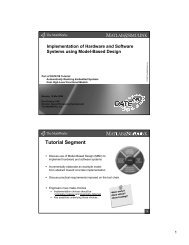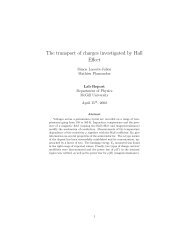Object-oriented framework for modelling and ... - ResearchGate
Object-oriented framework for modelling and ... - ResearchGate
Object-oriented framework for modelling and ... - ResearchGate
Create successful ePaper yourself
Turn your PDF publications into a flip-book with our unique Google optimized e-Paper software.
Modelling with object-<strong>oriented</strong> approaches is based on the concepts of hierarchy <strong>and</strong> taxonomy<br />
which are the two organising principles in ecology (Sequeira et al. 1991). By composition, the simula-<br />
tion of a cell space can be constructed in a hierarchical way (Fig. 9). We use the system entity structure<br />
(SES) to represent the simulation model composition (Zeigler, 1984). SES allows to refine object-<br />
<strong>oriented</strong> hierarchical trees generally provided in ecological <strong>modelling</strong> literature (Chen, 1997; Baveco<br />
<strong>and</strong> Lingeman, 1992) differentiating single <strong>and</strong> multi-decomposition. In a SES a single bar (|) represents<br />
single decomposition <strong>and</strong> a triple bar (|||) represents multi-decomposition.<br />
The Simulator class is composed of object classes such as the synchronization kernel (Synchro. Ker-<br />
nel) that uses the time (Time) to sort <strong>and</strong> schedule environmental events (Events) that are heaped in an<br />
event list (Event List). Using the simulation kernel, the Simulator manages the simulation of the World<br />
<strong>modelling</strong> package. The <strong>for</strong>mer is also composed of the Cell Space class <strong>and</strong> the Experimental Frame<br />
one. Here, the Experimental Frame can be seen as an object selecting data from real world <strong>and</strong> validat-<br />
ing simulation results. In the World Modelling Package, behavior <strong>and</strong> structure are separated. In eco-<br />
logical propagation, structure concerns parcels of l<strong>and</strong>scape. More precisely structure concerns the value<br />
of the model’s state variables in each parcel (biomass, presence of an organism, food resources, etc.)<br />
(Laval, 1996; Congleton et al., 1997). Each state variable of a parcel (which generally corresponds to<br />
rasters of Geographical In<strong>for</strong>mation System (GIS)) is embedded in an array of object cells (Parcel At-<br />
tributes) thus containing multiple state variables. Dynamics of the parcels changing one of their state<br />
variables is achieved through a Vector of active cells.<br />
Modelling of ecological systems needs different abstraction levels communicating together. More<br />
generally, holistic <strong>and</strong> reductionistic views can be used to complementarily specify a model (Goguen<br />
<strong>and</strong> Varela, 1979; Jørgensen, 2001). Besides the cell’s rules used to represent the system dynamics at a<br />
20




